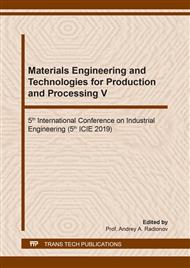[1]
V.K. Dragunov, M.V. Chepurin Electron beam welding of dissimilar alloys in the conditions of thermoelectric currents generation, Welding Production. 12 (2001) pp.8-16.
DOI: 10.1080/09507110209549560
Google Scholar
[2]
A.L. Goncharov, Investigation of thermoelectric power for steels and alloys of various structural classes during the process of electron beam welding, Welding Production. 4 (2010) pp.12-17.
Google Scholar
[3]
M. Ziolkowski, B. Hartmut, Modelling of Seebeck effect in electron beam deep welding of dissimilar metals, COMPEL: The International Journal for Computation and Mathematics in Electrical and Electronic Engineering. Vol. 28. (2009).
DOI: 10.1108/03321640910918940
Google Scholar
[4]
Chen, Xin & Pang, Shengyong & Shao, Xinyu & Wang, Chunming & Xiao, Jianzhong & Jiang, Ping.. Three-dimensional transient thermoelectric currents in deep penetration laser welding of austenite stainless steel. Optics and Lasers in Engineering. 91. (2017) pp.196-205.
DOI: 10.1016/j.optlaseng.2016.12.001
Google Scholar
[5]
G.M. Mladenov, D.N. Trushnikov, E.G. Koleva, V.Ya. Belenkiy, Parameters and some applications of plasma generated during keyhole welding using a highly concentrated energy beam – an overview, International Journal of Engineering Research & Science (IJOER). Vol. 2. Issue 3. March (2016).
Google Scholar
[6]
Nguyen-Kuok Shi. Theory of Low-Temperature Plasma Physics, Springer, New York, (2017).
Google Scholar
[7]
P.I. Blakeley, A. Sanderson The origin and effect of magnetic fields in electron beam welding, Weld. J. Vol. 63. 1 (1984) 42-49.
Google Scholar
[8]
I. Ruge, C. Oestmann, I. Decker et al., Welding of dissimilar by using the method of electron beam welding with filler wire, / Electron and Laser beam weld. Proc. Int. Conf, Tokyo, 14–15 July, 1986. Oxford e. a., 1986, pp.193-203.
Google Scholar
[9]
O.K. Nazarenko, Electron beam deviation during the process of electron beam welding, Automatic welding. 1 (1982) 33-39.
Google Scholar
[10]
G. Neubert, M. Spiegler Verfahren zum selbsttatigen Positionieren des Strahls beim Elektronenstrahlschweiben, ZIS.-Mitt. Bd. 18, 2 (1976) 152-158.
Google Scholar
[11]
K. Watanabe, T. Shida, M. Susuki et al. Some problems associated with deep penetration electron beam welding of heavy section steels, 2nd Int. Symp. Jap. Weld. Soc. Osaka. Vol. 1. (1975) 69-74.
Google Scholar
[12]
K. Watanabe, T. Shida, M. Susuki et al. A study on occurrence and prevention of defects of EBW (report 2), J. Jap. Weld. Soc. Vol. 44, 2 (1975) pp.121-127.
Google Scholar
[13]
P.S. Wei, T.W. Lii Elektron beam deflection when welding dissimilar metals, ASME Journal of Heat Transfer. Vol.112, 8 (1990) 714-720.
DOI: 10.1115/1.2910445
Google Scholar
[14]
N.V. Kropotin, V.G. Lebedev, D.A. Fedosimov, Investigation of a binary alloy crystallization process in auto-model approximation, Chemical Physics and Mesoscopy. Т. 10, №4, pp.436-447.
Google Scholar
[15]
V.A. Erofeev, Yu.Yi. Levin, A.V. Maslennikov, Simulation of non-stationary formation of welded joints in pulsed laser welding, Welding and Diagnostics. 3 (2010) pp.17-21.
Google Scholar
[16]
Lei Wang, Nan Wang, Nikolas Provatas Liquid channel segregation and morphology and their relation with hot cracking susceptibility during columnar growth in binary alloys, Acta Materialia. Vol. 127. (2017) 302-312.
DOI: 10.1016/j.actamat.2016.11.058
Google Scholar
[17]
S. Kou, A simple index for predicting the susceptibility to solidification cracking, Welding Journal. Volume 94. Issue 12. December 2015. pp.374s-388s.
Google Scholar
[18]
Mei Yunpeng, Liu Yongchang, Liu Chenxi, Li Chong, Yu Liming, Guo Qianying, Li Huijun Effect of base metal and welding speed on fusion zone microstructure and HAZ hot-cracking of electron-beam welded Inconel 718, Materials & Design. Volume 89. 5 January 2016. pp.964-977.
DOI: 10.1016/j.matdes.2015.10.082
Google Scholar
[19]
V.V. Novokreshchenov, R.V. Rodyakina, M.A. Karimbekov, Physical and technological features of formation of large thickness welded joints in electron beam welding. Solid State Phenomena. Vol. 265 SSP. (2017) 237-244.
DOI: 10.4028/www.scientific.net/ssp.265.237
Google Scholar
[20]
A.V. Shcherbakov, R.V. Rodyakina, A.S. Kozhechenko, D.A. Gaponova, A.L. Foncharov, V.K. Dragunov, An experimental study of current-density distributions of a technological electron beam, Technical Physics Letters. Volume 43. Issue 11. Novemner 2017, pp.958-960.
DOI: 10.1134/s1063785017110104
Google Scholar


